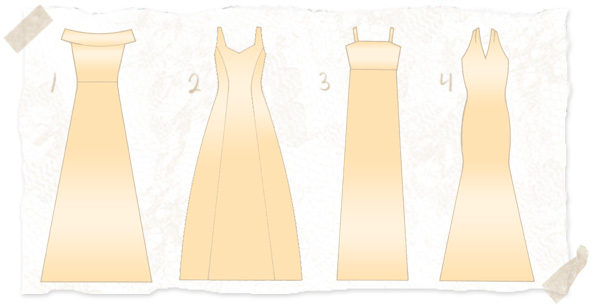
1. Off shoulder + A line dress
2. Heart shaped neckline + Princess line dress
3. Empire waistline + Straight line dress with strap
4. Halter neckline + Mermaid line dress
Type of fabric
Silk
Silk comes from silkworm cocoons made of natural fibres. The fibre cross-section is triangular, giving the distinctive reflective sheen. Light and durable, soft, breathable and moisture absorption resistant. This is the best material for a wedding or evening dress.
Cotton
A natural fibre that grows in the seed pod of the cotton plant. It can withstand high temperatures, hold warmth and is very easy to dye.
Linen
A fabric made from linen fibres obtained from inside the woody stem of the flax plant. Linen fibres are much stronger and more lustrous than cotton. Linen fabrics are very cool and absorbent, but wrinkle very easily, unless blended with manufactured fibres.
Wool
This fibre is made from the hair of various animals such as sheep, llamas, camels and goats. It is very resilient and resistant to wrinkling. It is renewed by moisture and well known for its warmth.
Polyester
A manufactured fibre. Polyester has high strength, excellent resiliency, and high abrasion resistance. Low absorbency allows the fibre to dry quickly. It’s shape is determined by heat and it is insensitive to moisture. It is lightweight, strong and resistant to creasing, shrinking, stretching, and mildew. It is readily washable and is not damaged by sunlight or weather and is resistant to moths.
Acetate
A manufactured fibre formed by compound of cellulose, refined from cotton linters and/or wood pulp, and acidic acid that has been extruded through a spinneret and then hardened. It is soft and has a crisp feel.
- Tulle image
- Silk satin image
- Lace image
- Organza image
- Acetate satin image
- Silk georgette image
Fabric Name
Shantung
A medium-weight, plain weave cotton, silk, rayon, synthetic fabric, characterised by a ribbed effect, resulting from slubbed yarns used in the warp or filling direction. Wrinkles quite a bit.
Doupion
An irregular silk thread reeled from two or more entangled cocoons and producing a coarse yarn generally used in fabrics such as shantung or pongee. Doupion’s surface has a more slubbed effect than shantung.
Satin
A traditional fabric utilising a satin weave construction to achieve a lustrous fabric surface. Satin is a traditional fabric for evening and wedding garments. This fabric made from silk, polyester and acetate usually has a lustrous surface and a dull back.
Duchesse
This form of satin has a wonderful lustre and a smooth feel. It’s thread count is very high. Very fine yarns are used, particularly in the warp with more ends/inch than picks. The material is string, has a high lustre, and texture. Characterised by grainy twill on back. This fabric is made of silk or polyester.
Organza
A crisp, sheer, lightweight plain weave fabric, with a medium to high yarn count , made of silk, rayon, nylon, or polyester. It has a very wiry feel. It crushes or musses fairly easily, but it is easily pressed. A dressy type of fabric, sometimes has a silvery sheen.
Chiffon
A plain woven lightweight, extremely sheer, airy, and containing highly twisted filament yarns. Made with very fine, tightly twisted yarns. It has a slightly bumpy look. This fabric is made from silk, rayon or other mixed fibres.
Georgette
Soft feeling, a sheer lightweight fabric, often made of silk or polyester, with a crepe surface. This fabric is slightly thicker than chiffon.
Tulle
A lightweight, extremely fine, machine-made netting, usually with a hexagonal shaped mesh effect.








